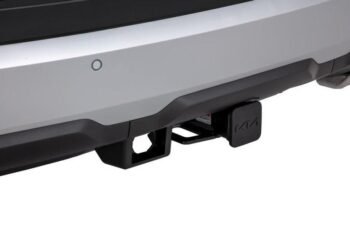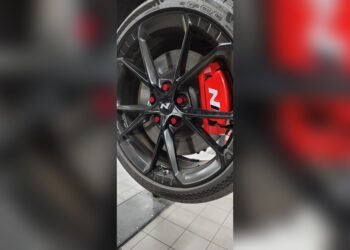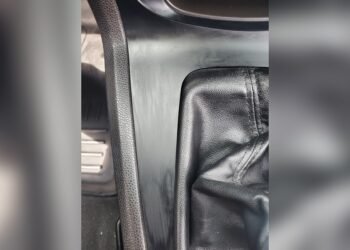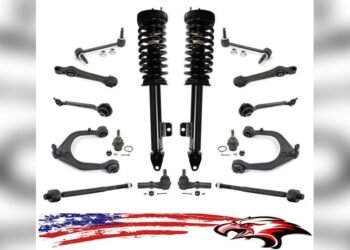When it comes to your vehicle’s safety, every detail counts—especially the way your wheels attach to the hub. You might have heard that applying anti-seize lubricant on the wheel hub can prevent rust and make future removals easier.
But is this really a good idea? Using anti-seize on your wheel hub might seem helpful, but it can actually cause serious problems like wheel slippage, improper torque, and even brake issues. If you want to keep your wheels secure and your drives safe, it’s crucial to know when and how to use anti-seize properly.
Read on to discover the risks of putting anti-seize on your wheel hub and the best practices to protect your vehicle—and yourself—on the road.
Credit: f80.bimmerpost.com
Purpose Of Anti-seize
Anti-seize is a special lubricant designed to prevent metal parts from sticking together. It helps stop corrosion and makes it easier to remove parts later. On wheel hubs, its main role is to protect metal surfaces from rust and seizing. This ensures parts do not get stuck due to heat, moisture, or dirt over time. Using anti-seize correctly can save time and effort during maintenance or repairs.
Common Uses In Automotive
Anti-seize is widely used on bolts, nuts, and threaded parts. Mechanics apply it to brake components, exhaust systems, and spark plugs. It helps prevent rust and makes future disassembly easier. In cold or wet climates, anti-seize protects parts exposed to harsh conditions. It also reduces the risk of damage from overtightening by allowing smooth tightening and loosening.
Why People Consider It For Wheel Hubs
Many believe anti-seize stops wheel hubs from rusting and sticking. They think it will make wheel removal easier after long use. Some apply it between the wheel and hub to prevent corrosion build-up. Others use it on wheel studs to reduce thread damage. The goal is to keep wheels safe and easy to maintain over time.
Risks Of Using Anti-seize On Wheel Hubs
Using anti-seize on wheel hubs involves notable risks. It may seem helpful to prevent rust, but it can reduce safety. The wheel’s connection to the hub relies on proper friction and torque. Adding anti-seize changes these crucial factors, leading to problems that affect vehicle stability and braking. Understanding these risks helps avoid dangerous situations on the road.
Reduced Friction And Wheel Stability
Anti-seize acts as a lubricant on the wheel hub surface. This reduces the friction that keeps the wheel firmly in place. Without enough friction, the wheel can slip or move slightly during driving. Such movement affects wheel stability and can cause vibrations or uneven tire wear. The risk of wheel loosening increases, compromising safe driving.
Impact On Lug Nut Torque
Applying anti-seize to lug nut threads changes the torque readings. The lubricant lowers friction between the threads. This makes the lug nuts feel tight at a lower clamping force. Over-tightening may happen unknowingly, or the nuts may seem secure but are not. Incorrect torque can lead to lug nuts loosening over time.
Potential For Wheel Separation
Reduced friction and incorrect torque together raise the chance of wheel separation. The wheel may not stay fully attached during strong forces like braking or turning. This separation is a serious safety hazard that can cause accidents. Proper hub and stud conditions are essential to avoid this risk.
Brake Rotor Contamination
Anti-seize can spread from the hub to the brake rotor surface. This contaminates the rotor and brake pads. Contamination reduces braking efficiency and can cause noise or vibrations. Clean, dry rotors are vital for safe and effective braking performance.
Manufacturer Recommendations
Manufacturers provide clear guidelines on using anti-seize on wheel hubs. Following these rules ensures safety and proper function. Ignoring them can cause serious problems, such as wheel loosening or damage. Understanding these recommendations helps avoid costly repairs and accidents.
Clean And Dry Surfaces
Manufacturers advise keeping wheel hub surfaces clean and dry. No grease, oil, or anti-seize should be applied to the mating surfaces. Dirt or lubricant reduces friction, which is vital for securing the wheel tightly. Clean surfaces allow the wheel to grip the hub firmly, preventing slippage during driving.
Proper Torque Specifications
Correct torque on lug nuts is essential for wheel safety. Anti-seize can alter torque readings, causing under-tightening or over-tightening. Manufacturers stress using a torque wrench and following their specified torque values. This ensures the wheel is fastened securely without damaging the studs or hub.

Credit: www.youtube.com
Safe Alternatives
Safe alternatives to using anti-seize on wheel hubs focus on proper maintenance and correct installation. These methods keep the wheel secure without risking slippage or improper torque. Following simple steps ensures safety and longevity of wheel components.
Cleaning The Wheel Hub And Studs
Always clean the wheel hub and studs before installation. Remove rust, dirt, and debris using a wire brush or brake cleaner. Clean surfaces improve the fit and prevent movement. A clean hub ensures proper contact between the wheel and hub.
Using Correct Torque Tools
Use a torque wrench to tighten lug nuts to manufacturer specifications. Proper torque prevents over-tightening or under-tightening. Correct torque keeps the wheel firmly in place and avoids damage to studs or nuts. Relying on accurate tools supports vehicle safety.
Avoiding Lubricants On Contact Surfaces
Do not apply lubricants on the wheel hub mating surfaces or studs. Lubricants reduce friction, which is necessary for wheel stability. Dry and clean contact points ensure the wheel stays secure during driving. Avoiding lubrication prevents loosening and potential accidents.
When Anti-seize Is Appropriate
Knowing when to use anti-seize on a wheel hub is key to safe vehicle maintenance. Anti-seize helps prevent metal parts from sticking together, but it is not always the right choice. Applying it in the wrong place can lead to serious problems with wheel safety and performance.
This section explains the proper situations for anti-seize use. Understanding these helps avoid damage and ensures your wheels stay secure and easy to service.
Non-mating Surfaces
Anti-seize is best for parts that do not directly hold the wheel in place. Use it on areas where metal parts touch but do not need strong friction. For example, apply anti-seize on brake rotor screws or caliper bolts. These parts can corrode or seize over time, making future repairs difficult.
On non-mating surfaces, anti-seize stops rust and eases removal. It does not affect the wheel’s grip or safety here. Always avoid putting anti-seize where the wheel hub and wheel meet directly.
Preventing Seizing On Other Components
Anti-seize works well on components prone to corrosion and heat damage. Exhaust bolts, spark plugs, and suspension parts benefit from it. These parts often face harsh conditions and seize easily.
Applying anti-seize ensures these components loosen smoothly during repairs. This saves time and reduces the risk of breaking bolts or nuts. Use anti-seize carefully and sparingly, following manufacturer guidelines for each part.
Step-by-step Hub Preparation
Proper preparation of the wheel hub is essential before installing new components. This process ensures a secure fit and prevents future problems like corrosion or wheel loosening. Follow these step-by-step instructions to prepare the hub correctly.
Removing Rust And Debris
Start by cleaning the hub surface thoroughly. Use a wire brush to remove rust and loose debris. Scrape off any old grease or dirt stuck on the hub. This step helps the wheel sit flush and prevents uneven wear.
Inspecting For Damage
Check the hub for cracks, dents, or deep rust pits. Look closely at the mounting surface and studs. Any damage can affect wheel alignment and safety. Replace or repair damaged parts before moving on.
Final Cleaning Tips
Use a clean cloth with brake cleaner or rubbing alcohol to wipe the hub. Make sure the surface is dry and free of oil or grease. Avoid using anti-seize on the hub or studs, as it reduces needed friction. A clean, dry surface ensures a tight, safe wheel fit.
Common Misconceptions
Many people misunderstand the role of anti-seize on wheel hubs. This confusion can lead to improper use and safety risks. Clearing these common misconceptions helps ensure safe and reliable wheel installation.
Lubrication Vs. Secure Fit
Anti-seize acts as a lubricant, reducing friction between the wheel and hub. Friction is crucial for a secure fit. A clean, dry surface helps prevent wheel movement during driving. Using anti-seize can cause the wheel to slip on the hub. This slipping increases the risk of wheel loosening or separation.
Torque Feel Vs. Actual Clamping Force
Applying anti-seize on lug nut threads changes torque readings. The lug nut may feel tight at the recommended torque. The actual clamping force, however, becomes lower. This difference can cause the wheel to come loose. Proper clamping force relies on dry, clean threads for accuracy.

Credit: www.reddit.com
Frequently Asked Questions
Should You Use Anti-seize On Wheel Hubs?
Do not use anti-seize on wheel hubs or studs. It reduces friction, compromises torque, and risks wheel loosening. Clean and dry the hub and studs before installation to ensure safety and proper torque.
Can You Put Anti-seize On A Rotor Hub?
No, do not apply anti-seize on a rotor hub. It reduces friction, risks wheel loosening, and contaminates brake surfaces. Keep the hub clean and dry for safe wheel installation.
Should You Put Grease Between A Wheel And A Hub?
Do not put grease or anti-seize between the wheel and hub. Keep surfaces clean and dry for proper friction and secure fit.
When Shouldn’t You Use Anti-seize?
Avoid using anti-seize on wheel hubs and studs. It reduces friction, alters torque, risks wheel loosening, and may contaminate brakes. Keep hub surfaces clean and dry for safe, secure wheel installation.
What Is Anti-seize On A Wheel Hub?
Anti-seize is a lubricant used to prevent rust and corrosion on metal parts.
Conclusion
Applying anti-seize on the wheel hub can cause serious safety risks. It reduces the friction needed to keep wheels secure. This may lead to loose wheels and brake problems. Always keep the hub and studs clean and dry. Use the correct torque on lug nuts without lubricants.
This simple step helps ensure your wheels stay safely attached. Proper maintenance protects your vehicle and keeps you safe on the road. Remember, less is more when it comes to wheel hub care.

















